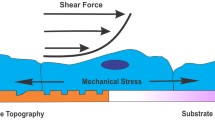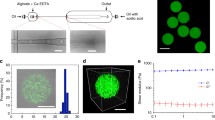Abstract
The formulation of more accurate models to describe tissue mechanics necessitates the availability of tools and instruments that can precisely measure the mechanical response of tissues to physical loads and other stimuli. In this regard, neuroscience has trailed other life sciences owing to the unavailability of representative live tissue models and deficiency of experimentation tools. We previously addressed both challenges by employing a novel instrument called the cantilevered-capillary force apparatus (CCFA) to elucidate the mechanical properties of mouse neurospheres under compressive forces. The neurospheres were derived from murine stem cells, and our study was the first of its kind to investigate the viscoelasticity of living neural tissues in vitro. In the current study, we demonstrate the utility of the CCFA as a broadly applicable tool to evaluate tissue mechanics by quantifying the effect that oxidative stress has on the mechanical properties of neurospheres. We treated mouse neurospheres with non-cytotoxic levels of hydrogen peroxide and subsequently evaluated the storage and loss moduli of the tissues under compression and tension. We observed that the neurospheres exhibit viscoelasticity consistent with neural tissue and show that elastic modulus decreases with increasing size of the neurosphere. Our study yields insights for establishing rheological measurements as biomarkers by laying the groundwork for measurement techniques and showing that the influence of a particular treatment may be misinterpreted if the size dependence is ignored.







Similar content being viewed by others
References
Budday S et al (2017) Mechanical characterization of human brain tissue. Acta Biomater 48:319–340
Budday S et al (2017) Rheological characterization of human brain tissue. Acta Biomater 60:315–329. https://doi.org/10.1016/j.actbio.2017.06.024
Budday S et al (2019) Fifty shades of brain: a review on the mechanical testing and modeling of brain tissue. Arch Comput Methods Eng 27(4):1187–1230. https://doi.org/10.1007/s11831-019-09352-w
Budday S et al (2020) Modeling the life cycle of the human brain. Curr Opin Biomed Eng 15:16–25. https://doi.org/10.1016/j.cobme.2019.12.009
Christensen R (2012) Theory of viscoelasticity: an introduction. Elsevier, Amsterdam
Chui A et al (2020) Oxidative stress regulates progenitor behavior and cortical neurogenesis. Development. https://doi.org/10.1242/dev.184150
Chyasnavichyus M et al (2016) Probing elastic properties of soft materials with AFM: data analysis for different tip geometries. Polymer 102:317–325
Distler T et al (2021) Neuronal differentiation from induced pluripotent stem cell-derived neurospheres by the application of oxidized alginate-gelatin-laminin hydrogels. Biomedicines 9(3):261
Fallenstein GT et al (1969) Dynamic mechanical properties of human brain tissue. J Biomech 2(3):217–226
Frostad JM et al (2013) Cantilevered-capillary force apparatus for measuring multiphase fluid interactions. Langmuir 29(15):4715–4725. https://doi.org/10.1021/la304115k
Frostad JM et al (2014) Direct measurement of interaction forces between charged multilamellar vesicles\(\dagger\). Soft Matter 10(39):7769–7780. https://doi.org/10.1039/C3SM52785A
Frostad JM et al (2014) Direct measurement of the interaction of model food emulsion droplets adhering by arrested coalescence. Colloids Surf A 441:459–465. https://doi.org/10.1016/j.colsurfa.2013.09.028
Ghaemi RV et al (2015) Fluid-structure interactions analysis of shear-induced modulation of a mesenchymal stem cell: an image-based study. Artif Organs 40(3):278–287. https://doi.org/10.1111/aor.12547
Ghaemi RV et al (2018) Brain organoids: a new, transformative investigational tool for neuroscience research. Adv Biosyst 3(1):1800174. https://doi.org/10.1002/adbi.201800174
Gnanachandran K et al (2022) Discriminating bladder cancer cells through rheological mechanomarkers at cell and spheroid levels. J Biomech 144:111346
Guimarães CF et al (2020) The stiffness of living tissues and its implications for tissue engineering. Nat Rev Mater 5(5):351–370. https://doi.org/10.1038/s41578-019-0169-1
Han C et al (2015) Formation and manipulation of cell spheroids using a density adjusted PEG/DEX aqueous two phase system. Sci Rep 5(1):1–12
Hernández-García D et al (2010) Reactive oxygen species: a radical role in development? Free Radic Biol Med 49(2):130–143. https://doi.org/10.1016/j.freeradbiomed.2010.03.020
Hofer M et al (2021) Engineering organoids. Nat Rev Mater 6(5):402–420
Jorba I et al (2017) Probing micromechanical properties of the extracellular matrix of soft tissues by atomic force microscopy. J Cell Physiol 232(1):19–26
Juhee K et al (2018) Neurosphere development from hippocampal and cortical embryonic mixed primary neuron culture: a potential platform for screening neurochemical modulator. ACS Chem Neurosci 9(11):2870–2878
Kim S et al (2020) Engineering multi-cellular spheroids for tissue engineering and regenerative medicine. Adv Healthc Mater 9(23):2000608
Kutner MH et al (2005) Applied linear statistical models. McGraw-Hill, New York
Liu Z et al (2005) Protective effects of hyperoside (quercetin-3-o-galactoside) to PC12 cells against cytotoxicity induced by hydrogen peroxide and tert-butyl hydroperoxide. Biomed Pharmacother 59(9):481–490. https://doi.org/10.1016/j.biopha.2005.06.009
Liu Z et al (2015) The ambiguous relationship of oxidative stress, tau hyperphosphorylation, and autophagy dysfunction in Alzheimer’s disease. Oxid Med Cell Longev 2015:1–12. https://doi.org/10.1155/2015/352723
Lulevich V et al (2010) Single-cell mechanics provides a sensitive and quantitative means for probing amyloid-\(\beta\) peptide and neuronal cell interactions. Proc Natl Acad Sci 107(31):13872–13877
Luque-Contreras D et al (2014) Oxidative stress and metabolic syndrome: cause or consequence of Alzheimer’s disease? Oxid Med Cell Longev 2014:1–11. https://doi.org/10.1155/2014/497802
Macri-Pellizzeri L et al (2015) Substrate stiffness and composition specifically direct differentiation of induced pluripotent stem cells. Tissue Eng Part A 21(9–10):1633–1641
Madhusudanan P et al (2020) Hydrogel systems and their role in neural tissue engineering. J R Soc Interface 17(162):20190505
McGuire BJ et al (2001) A theoretical model for oxygen transport in skeletal muscle under conditions of high oxygen demand. J Appl Physiol 91(5):2255–2265
Meyers MA et al (2008) Mechanical behavior of materials. Cambridge University Press, Cambridge
Miller K et al (2002) Mechanical properties of brain tissue in tension. J Biomech 35(4):483–490
Núñez FJ et al (2019) Evaluation of biomarkers in glioma by immunohistochemistry on paraffin-embedded 3D glioma neurosphere cultures. JoVE. https://doi.org/10.3791/58931
Okwara CK et al (2021) The mechanical properties of neurospheres. Adv Eng Mater 23(8):2100172. https://doi.org/10.1002/adem.202100172
Pei-Hsun W et al (2018) A comparison of methods to assess cell mechanical properties. Nat Methods 15(7):491–498
Place TL et al (2017) Limitations of oxygen delivery to cells in culture: an underappreciated problem in basic and translational research. Free Radic Biol Med 113:311–322
Pogoda K et al (2014) Compression stiffening of brain and its effect on mechanosensing by glioma cells. New J Phys 16(7):075002
Roylance D (2001) Engineering viscoelasticity. In: Department of Materials Science and Engineering–Massachusetts Institute of Technology, Cambridge 2139 (2001), pp. 1–37
Sharma RK et al (2008) Effect of oxidative preconditioning on neural progenitor cells. Brain Res 1243:19–26. https://doi.org/10.1016/j.brainres.2008.08.025
Shi W et al (2021) Design and evaluation of an in vitro mild traumatic brain injury modeling system using 3D printed mini impact device on the 3D cultured human iPSC derived neural progenitor cells. Adv Healthc Mater 10(12):2100180. https://doi.org/10.1002/adhm.202100180
Silvia B et al (2015) Mechanical properties of gray and white matter brain tissue by indentation. J Mech Behav Biomed Mater 46:318–330. https://doi.org/10.1016/j.jmbbm.2015.02.024
Simon M et al (2016) Load rate and temperature dependent mechanical properties of the cortical neuron and its pericellular layer measured by atomic force microscopy. Langmuir 32(4):1111–1119
Skylar-Scott Mark A et al (2019) Biomanufacturing of organ-specific tissues with high cellular density and embedded vascular channels. Sci Adv 5(9):eaaw2459
Soman P et al (2012) Three-dimensional scaffolding to investigate neuronal derivatives of human embryonic stem cells. Biomed Microdevices 14(5):829–838
Stanisavljevic J et al (2015) Snail1-expressing fibroblasts in the tumor microenvironment display mechanical properties that support metastasis. Cancer Res 75(2):284–295
Thakuri PS et al (2019) Synergistic inhibition of kinase pathways overcomes resistance of colorectal cancer spheroids to cyclic targeted therapies. ACS Pharmacol Transl Sci 2(4):275–284
van Pel DM et al (2018) Modelling glioma invasion using 3D bioprinting and scaffold-free 3D culture. J Cell Commun Signal 12:723–730
Xing Q et al (2017) Natural extracellular matrix for cellular and tissue biomanufacturing. ACS Biomater Sci Eng 3(8):1462–1476
Ye K et al (2018) Advanced cell and tissue biomanufacturing. ACS Biomater Sci Eng 4(7):2292–2307
Zieliński T et al (2022) Changes in nanomechanical properties of single neuroblastoma cells as a model for oxygen and glucose deprivation (OGD). Sci Rep 12(1):16276
Acknowledgements
This work was supported through funding from the Canada Foundation for Innovation and the Engage and Discovery Grants Program of the Natural Sciences and Engineering Research Council of Canada. The cantilevered-capillary force apparatus (CCFA) was designed and fabricated by John M. Frostad through funding from the Canada Foundation for Innovation.
Author information
Authors and Affiliations
Contributions
Yun-Han Huang contributed to formal analysis, investigation, data Curation, writing—original draft, writing—review and editing, visualization. Roza Vaez Ghaemi contributed to conceptualization, methodology, software, validation, formal analysis, investigation, data curation, writing—original draft, writing—review and editing, visualization. James Cheon contributed to formal analysis, investigation, data curation, writing—original draft, visualization. Vikramaditya G. Yadav contributed to conceptualization, methodology, formal analysis, resources, writing—original draft, writing—review and editing, supervision, project administration, funding acquisition. John M. Frostad contributed to conceptualization, methodology, formal analysis, resources, writing—original draft, writing—review and editing, supervision, project administration, funding acquisition.
Corresponding authors
Ethics declarations
Conflict of interest
The authors declare that they do not have any conflicts of interest.
Additional information
Publisher's Note
Springer Nature remains neutral with regard to jurisdictional claims in published maps and institutional affiliations.
Rights and permissions
Springer Nature or its licensor (e.g. a society or other partner) holds exclusive rights to this article under a publishing agreement with the author(s) or other rightsholder(s); author self-archiving of the accepted manuscript version of this article is solely governed by the terms of such publishing agreement and applicable law.
About this article
Cite this article
Huang, YH., Vaez Ghaemi, R., Cheon, J. et al. The mechanical effects of chemical stimuli on neurospheres. Biomech Model Mechanobiol (2024). https://doi.org/10.1007/s10237-024-01841-7
Received:
Accepted:
Published:
DOI: https://doi.org/10.1007/s10237-024-01841-7




